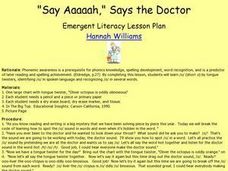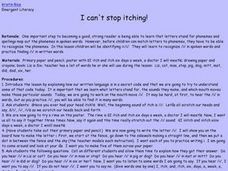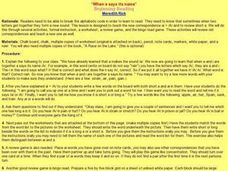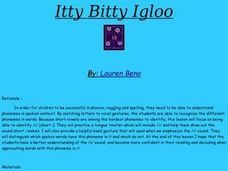Curated OER
What Did You Say?
Students recognize the short vowel E in written and spoken language. Through matching activities, they discriminate the short vowel /e/ from other phonemes. Students associate the phoneme with its letter representation and read pseudo...
Curated OER
Icky, Icky, Sticky!
Students recognize the short vowel I in written and spoken language. Through matching activities, they discriminate the short vowel /i/ from other vowel sounds. Students associate the phoneme with its letter representation and identify...
Curated OER
Say Ahh Went the Doc
Students recognize the short vowel O in written and spoken language. Through matching activities, they discriminate the short vowel /o/ from other vowel sounds. Students associate the phoneme with its letter representation and identify...
Curated OER
Beginning to Read
Young scholars explore the short /u/ sound. They practice making the sound, noticing how their mouths move to make it. They recite tongue twisters with short /u/ words and use letterboxes to spell 'u' words. They identify short /u/ words...
Curated OER
Aaah, I'm hungry
First graders recognize the short vowel a in written and spoken language. Through matching activities, they discriminate the short vowel /a/ from other phonemes. Students associate the phoneme with its letter representation and spell...
Curated OER
Opera Singer
Students recognize the short vowel o in written and spoken language. Through listening and decoding activities, they discriminate the vowel sound /o/ from other phonemes. Students identify the phoneme and letter in pseudo words they read.
Curated OER
Allie The Alligator
Students recognize the short vowel a in written and spoken language. Through listening activities, they discriminate the vowel sound /a/ from other phonemes. Students associate the phoneme with its letter representation and identify them...
Curated OER
"The Scary Letter...aaaaaaaaaa!!!"
Students study the /a/ using the hand gesture and 'aaa' sound as if they were seeing a ghost. Next, they recite a tongue twister and make words using letter boxes using different numbers of phonemes. Next, they read "Pat's Jam" out loud...
Curated OER
I Am Tired
First graders recognize the short vowel o in written and spoken language. Through listening and matching activities, they discriminate the vowel sound /o/ from other phonemes. Students associate the phoneme with its letter representation...
Curated OER
Icky Sticky
Students examine the letter 'i'. Through instruction and modeling they explore the sound the letter makes, how the letter is written, words that contain the letter, etc. They identify names of items with the short /i/ sound in them and...
Curated OER
Apple
First graders recognize the short vowel a in written and spoken language. Through matching and listening activities, they discriminate the vowel sound /a/ from other phonemes. Students associate the phoneme with its letter representation...
Curated OER
Say Aaaaah, Says the Doctor
Pupils explore the short /o/ sound using tongue twisters. They identify the /o/ sound in spoken language and recognize the /o/ in written words. Students practice writing the letter o. They spell words with the /o/ sound and they read In...
Curated OER
Oscar says Ahhh
Students recognize the short vowel o in written and spoken language. Through matching and listening activities, they discriminate the short vowel /o/ from other phonemes. Students associate the phoneme with its letter representation and...
Curated OER
I Love to Eat Apples!
Learners study the a=/a/ correspondence by first examining how they hold their mouths when biting into an apple. They practice the sound while reciting a tongue twister and making a gesture each time they hear the /a/. While looking at...
Curated OER
Uh??? I Don't Know
Young scholars explore the short /u/ sound. They practice making the sound and use letterboxes to spell 'u' words. They recite tongue twisters and read with a partner, 'Fuzz and the Buzz.' They practice writing 'u' words and draw a...
Curated OER
Icky Sticky Inchworm
Pupils examine the letter 'i'. Through instruction and modeling they explore the sound the letter makes, how the letter is written, words that contain the letter, etc. They use letterboxes to write 'i' words and read stories containing...
Curated OER
Uhhh...Did I Do That?
Students complete a variety of activities as they explore the letter u as it makes the short /u/ sound. They recite short /u/ tongue twisters and using Elkonin letter boxes, they spell words with the letter u. They also practice writing...
Curated OER
I Can't Stop Itching
Students recognize the short vowel i in written and spoken language. Through matching and listening activities, they discriminate the vowel sound /i/ from other phonemes. After reading the story "Liz is Six," students draw a picture with...
Curated OER
When A Says Its Name
Students are introduced to the concept of vowel digraphs. They identify the digraph /ai/ in spoken language. After a brief discussion, students apply the rule for reading and spelling words containing the /ai/ digraph by playing word bingo.
Curated OER
Icky Sticky
First graders the /i/ sound by practicing the way the mouth moves while making the sound while saying "icky, sticky." They write the letter "i" using both upper and lower case letters, make words using letterboxes, and write about a...
Curated OER
Aa
In this Aa worksheet, students identify words that begin with the short a sound by circling the pictures. Pictures include ant, apple, alphabet, ambulance and alligator.
Curated OER
Icky "I"
Students recognize the short vowel i in written and spoken language. Through matching and listening activities, they discriminate the short vowel /i/ from other phonemes. Students associate the phoneme with its letter representation and...
Curated OER
Itty Bitty Igloo
Pupils recognize the short vowel i in written and spoken language. Through listening activities, they discriminate the vowel sound /i/ from other phonemes. Students associate the phoneme with its letter representation and identify the...
Curated OER
Abigail Ant
Pupils recognize the short vowel a in written and spoken language. Through matching and listening activities, they discriminate the vowel sound /a/ from other phonemes. Students identify the phoneme and letter in words and pictures.

























